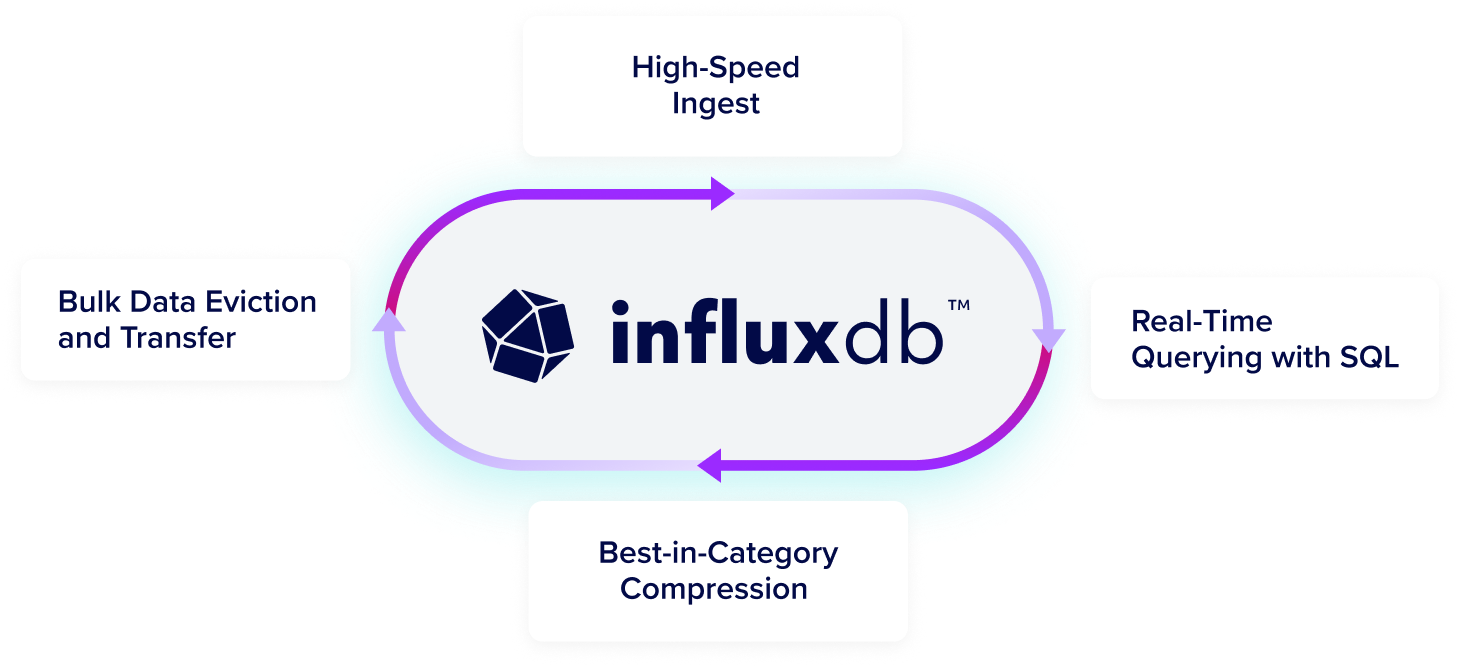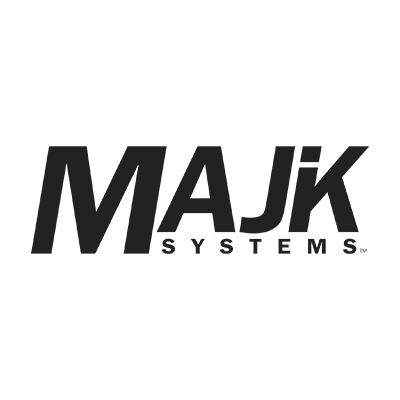InfluxDB for Infrastructure and Application Monitoring
The solution to monitor your entire infrastructure stack, including servers, containers, databases, and cloud services.
#1
Time Series Database
Source: DB Engines
1B+
Downloads of InfluxDB
Take the complexity out of time series data management
Try InfluxDBTurn high-volume, high-velocity, high-resolution time series data into actionable intelligence without sacrificing performance.
Get high-speed ingestion, real-time querying, and seamless scalability in a highly performant time series database that can handle unlimited volumes of time series data, even as data complexity and cardinality increases.
Run InfluxDB at scale in any environment in the cloud, on-premises, or at the edge. InfluxDB consists of the core database and storage engine, an API, and an ecosystem of tools and integrations to manage time-stamped data. Easily integrate with 5K+ prebuilt connections using Telegraf, our open source agent with 5B+ downloads.
Run InfluxDB 3 where you need it
Start for free, scale in seconds
Start NowFor small workloads and getting started
Deploy anywhere: on-prem, private cloud, edge, or multi-tenant cloud.
Secure, dedicated cloud infrastructure
Run a Proof of ConceptFor scaled workloads
Fully-managed, single-tenant service with unlimited scale, high availability, secure private connections, and enhanced Support.
Own your data with enterprise features
Run a Proof of ConceptFor scaled workloads
Control your infrastructure with unlimited scale, high availability, enterprise-grade security, and enhanced Support. On-prem, private cloud, and edge deployment.
Why InfluxDB
Limitless data collection
Ingest and analyze millions of time series data points per second without limits or caps.
Predict and prevent
Maximize uptime and prevent costly failures with real-time monitoring and preventative insights.
Real-time query
Data is immediately available for querying in InfluxDB, enabling real-time SQL queries and lightning-fast responses.
What infrastructure and application monitoring can solve for you
Efficiently finding and addressing infrastructure and application issues through proactive monitoring is critical to providing your users with the great experience they deserve.
Emerging trends like microservices, containerization, elastic storage, software-defined networking, and hybrid clouds are pushing the boundaries of what constitutes DevOps monitoring. InfluxDB can monitor and control private and public cloud infrastructures (e.g., PaaS, SaaS, website), application, and database instances and the entire infrastructure including network servers, routers, and switches. Real-time infrastructure and application monitoring using InfluxDB help to identify and resolve problems before they affect critical business processes and plan for upgrades before outdated systems begin to cause failures.
Consolidated view
InfluxDB is a system of insight for all infrastructure monitoring. Integrated input plugins allow you to pull metrics from your system or third-party APIs or listen for metrics via StatsD and Kafka consumer services. And the output plugins send metrics to a host of external data stores, services, and message queues, including InfluxDB, Graphite, OpenTSDB, Datadog, Librato, Kafka, MQTT, NSQ and more. And if that doesn’t work for you, you can easily build your own plugin to fit your unique environment–we’ll never force you to pay extra for a custom plugin or adapt it to fit with a monitoring tool.
Real-time monitoring with precision
InfluxDB gives you visibility with real-time access out of the gate so you can quickly find value in your data—identifying patterns, predicting the future, controlling systems, and turning insights into action. Whether your data comes from servers, databases, or your applications, get instant insights and stay ahead of the curve.
Real-time monitoring requires keeping data at the right precision to support maintaining increasingly stronger SLAs. Issues that can negatively impact SLAs need to be addressed in real time, which often means in seconds not minutes. InfluxDB supports precision down to the nanosecond. It also allows for downsampling of that data. For instance, high-precision data can be kept for a short period with more extended retention periods for summary data at medium or lower precision.
Automation
Automation is a huge boon to organizations. Today’s agile organizations and modern applications require automatic computer-driven actions. InfluxDB allows for the definition of custom logic or user-defined functions to process alerts with dynamic thresholds, match metrics for patterns or compute statistical anomalies, automatically scale containers, and basically do anything that you can program. It can perform these analytics on streams as well as data stored in the database. InfluxDB’s simple plugin architecture, or interface, allows it to integrate with any anomaly-detection engine, machine learning libraries, pattern-matching engines, rules engines, and the like. InfluxData also provides notification services that can trigger Slack, PagerDuty, and others. The result is higher business value, with systems able to automatically react to metrics and patterns as they are detected.
Continuous delivery
Every organization strives to support continuous delivery so it can safely, quickly, and sustainably implement changes of all types. Through its scalability, flexibility, and reliability, InfluxDB enables not only advanced monitoring but, ultimately, business value creation—from providing the framework for testing in a production-like environment to releasing software updates faster, more frequently, and dependably. Successful DevOps execution brings enterprises closer to achieving continuous delivery.
InfluxDB’s open and extensible architecture can even help enterprises burdened with maintaining legacy systems to discover and address errors in these systems in the same manner that they do with newer systems. This allows them to avoid multiple point solution systems monitoring, application performance monitoring and business process monitoring.
Global distributed environments
Today’s SaaS solutions and internal data centers are part of a global platform. They are distributed geographically across cloud vendors and internal infrastructures. InfluxData offers a truly hybrid approach, allowing collection and running of the platform across cloud vendors, public clouds, private clouds, and on-premises. InfluxDB’s efficient clustering capabilities ensure service availability in this distributed, always-on world.
Read more about infrastructure and application monitoring implementations made available by the InfluxDB community
Telegraf Zipkin plugin: Zipkin tracing data can be collected via Telegraf and sent to InfluxDB.
Jaeger InfluxDB plugin: gRPC client plugin is used to collect tracing data and send it to InfluxDB.
Synthetic transaction monitoring: xSum emulates the user journey through a site or web application, ensuring that transactions take place error-free. All data is stored in InfluxDB.
Load testing: Flood.io is a distributed load testing platform that supports testing with open source tools like JMeter, Gatling, and Selenium. Flood.io’s platform collects and aggregates real-time data from the tests conducted by their customers in InfluxDB Cloud.
Open data standards drive performance and interoperability
InfluxDB 3 is built in Rust and the FDAP stack—Flight, DataFusion, Arrow, and Parquet—leveraging Apache-backed technologies to efficiently ingest, store, and analyze time series data at any scale.
Try InfluxDBF
Flight for efficient columnar data transfer

D
DataFusion for high-performance querying
A
Arrow for optimized in-memory columnar analytics

P
Parquet for high-compression storage
InfluxDB’s columnar database supports time series data at a lower TCO
See ways to get started
Loved by developers, trusted by enterprises
65M+
daly events processed
45x
more resource efficient
Siemens Energy
“[We] long used InfluxDB open source... Moving to commercial InfluxDB was a strategic move to unify our data infrastructure, ensuring we have the reliability, scalability, and real-time performance to keep pace with production... and proactive maintenance.”
Jan Petersen
Senior Manufacturing Engineer
500M+
Metrics collected daily
Mission-critical monitoring
Real-time data access for queries
LOFT ORBITAL
Space Made Simple: How Loft Orbital Delivers Unparalleled Speed-to-Space with InfluxDB Cloud
Read Case Study65M+
daly events processed
45x
more resource efficient
CAPITAL ONE
"InfluxDB is a high-speed read and write database. The data is written in real-time, you can read it in real-time, and while reading, you can apply your machine learning model. So, in real-time, you can forecast and detect anomalies."
Rajeev Tomer
Sr. Manager of Data Engineering
50%
lower total cost of ownership
100K
real-time metrics with simplified deployment
TERÉGA
Teréga Replaced Its Legacy Data Historian with InfluxDB
Lorem ipsum
Lorem ipsum dolor sit amet consectetur.
65M+
daly events processed
45x
more resource efficient
WIDEOPENWEST
"I was blown away with how easy it was to install and configure InfluxDB. The clustering was easy. The documentation was great, and the support has been second to none."
Dylan Shorter
Engineer III, Software and Product Integration Engineering
45%
Less equipment downtime
10%
Reduced waste
MAJIK SYSTEMS
From Reactive to Proactive: How MAJiK Systems Embraced Predictive Maintenance with InfluxDB and Time Series Data
Dylan Shorter
Engineer III, Software and Product Integration Engineering
65M+
daly events processed
45x
more resource efficient
JU:NIZ ENERGY
“With InfluxDB Cloud Dedicated, the great thing is that we don't need to think about data storage costs or usage anymore because data storage gets way cheaper.”
Ricardo Kissinger
Head of IT Infrastructure and IT Security









